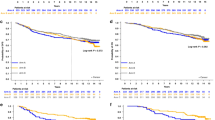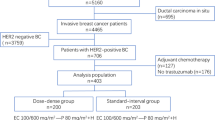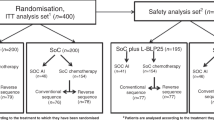Abstract
Anthracyclines and taxanes are very effective drugs in the treatment of advanced breast cancer. With G-CSF support, the dose-intensity of this combination can be increased by reducing the interval between chemotherapy cycles, the so-called ‘shortening of cycle time’. We treated 36 patients with advanced breast cancer in a multicentre phase I/II study. The treatment regimen consisted of epirubicin 75 mg m–2 followed by paclitaxel 135 mg m–2 (3 h) in combination with G-CSF. At least six patients were treated in each cohort and were evaluated over the first three cycles. Starting at an interval of 14 days, in subsequent cohorts of patients the interval could be shortened to 10 days. An 8-day interval was not feasible due mainly to incomplete neutrophil recovery at the day of the next scheduled cycle. In the 10-day interval cohort it was feasible to increase the paclitaxel dose to 175 mg m–2. The haematological and non-haematological toxicity was relatively mild. No cumulative myelosuppression was observed over at least three consecutive cycles. In combination with G-CSF, epirubicin 75 mg m–2 and paclitaxel 175 mg m–2 could be safely administered every 10 days over at least three cycles, enabling a dose intensity of 52 and 122 mg m–2 per week, respectively. © 2000 Cancer Research Campaign
Similar content being viewed by others
Article PDF
Change history
16 November 2011
This paper was modified 12 months after initial publication to switch to Creative Commons licence terms, as noted at publication
References
Brambilla C, Rossi A, Bonfante V, Ferrari L, Villani F, Crippa F and Bonadonna G (1986) Phase II study of doxorubicin versus epirubicin in advanced breast cancer. Cancer Treatment Report 70: 261–266
Catimel G, Spielmann M, Dieras V, Kayitalire L, Pouillart P, Guastalla JP, Soler-Michel P, Graffand N, Garet F, Dumortier A, Pellae-Cosset B and Chazard M (1996) Phase I study of paclitaxel and epirubicin in patients with metastatic breast cancer: a preliminary report on safety. Semin Oncol 23: 24–27
Conte PF, Michelotti A, Baldini E, Salvadori B, Gennari A, Da Prato M, Tibaldi C, Salzano E and Gentile A (1996) A dose-finding study of epirubicin in combination with paclitaxel in the treatment of advanced breast cancer. Semin Oncol 21: 28–31
Conte PF, Baldini E, Gennari A, Michelotti A, Salvadori B, Tibaldi C, Danesi R, Innocenti F, Gentile A, Dell’Anna R, Biadi O, Mariani M and Del Tacca M (1997) Dose-finding study and pharmacokinetics of epirubicin and paclitaxel over 3 hours: a regimen with high activity and low cardiotoxicity in advanced breast cancer. J Clin Oncol 15: 2510–2517
de Wit R, Verweij J, Bontenbal M, Kruit WH, Seynaeve C, Schmitz PI and Stoter G (1996) Adverse effect on bone marrow protection of prechemotherapy granulocyte colony-stimulating factor support [see comments]. J Natl Cancer Inst 88: 1393–1398
Eisenhauer EA, ten Bokkel Huinink WW, Swenerton KD, Gianni L, Myles J, van der Burg ME, Kerr I, Vermorken JB, Buser K and Colombo N (1994) European-Canadian randomized trial of paclitaxel in relapsed ovarian cancer: high-dose versus low-dose and long versus short infusion. J Clin Oncol 12: 2654–2666
Fisherman JS, McCabe M, Noone M, Ognibene FP, Goldspiel B, Venzon DJ, Cowan KH and O’Shaughnessy JA (1993) Phase I study of Taxol, doxorubicin, plus granulocyte-colony stimulating factor in patients with metastatic breast cancer. J Natl Cancer Inst Monograph 189–194
Gehl J, Boesgaard M, Paaske T, Vittrup Jensen B and Dombernowsky P (1996) Combined doxorubicin and paclitaxel in advanced breast cancer: effective and cardiotoxic. Ann Oncol 7: 687–693
Gennari A, Salvadori B, Donati S, Bengala C, Orlandini C, Danesi R, Del Tacca M, Bruzzi P and Conte PF (1999) Cardiotoxicity of epirubicin/paclitaxel-containing regimens: role of cardiac risk factors. J Clin Oncol 17: 3596–3602
Gianni L, Munzone E, Capri G, Villani F, Spreafico C, Tarenzi E, Fulfaro F, Caraceni A, Martini C and Laffranchi A 1995 a) Paclitaxel in metastatic breast cancer: a trial of two doses by a 3-hour infusion in patients with disease recurrence after prior therapy with anthracyclines. J Natl Cancer Inst 87: 1169–1175
Gianni L 1995 b) Theoretical and practical aspects of paclitaxel scheduling. Ann Oncol 6: 861–863
Gianni L, Munzone E, Capri G, Fulfaro F, Tarenzi E, Villani F, Spreafico C, Laffranchi A, Caraceni A and Martini C 1995 c) Paclitaxel by 3-hour infusion in combination with bolus doxorubicin in women with untreated metastatic breast cancer: high antitumor efficacy and cardiac effects in a dose-finding and sequence-finding study. J Clin Oncol 13: 2688–2699
Gilewski TA and Norton L (1996) Cytokinetics and breast cancer chemotherapy. In: Diseases of the Breast Harris JR, Lippman ME, Morrow M, Hellman S (eds) pp 751–768, Lippincott-Raven: Philadelphia
Henderson IC, Hayes DF and Gelman R (1988) Dose-response in the treatment of breast cancer: a critical review. J Clin Oncol 6: 1501–1515
Hortobagyi GN, Willey J, Rahman Z, Holmes FA, Theriault RL and Buzdar AU (1997) Prospective assessment of cardiac toxicity during a randomized phase II trial of doxorubicin and paclitaxel in metastatic breast cancer. Semin Oncol 24: 65–68
Jain KK, Casper ES, Geller NL, Hakes TB, Kaufman RJ, Currie V, Schwartz W, Cassidy C, Petroni GR and Young CW (1985) A prospective randomized comparison of epirubicin and doxorubicin in patients with advanced breast cancer. J Clin Oncol 3: 818–826
Kobrinsky NL, Sjolander DE, Cheang MS, Levitt R and Steen PD (1999) Granulocyte-macrophage colony-stimulating factor treatment before doxorubicin and cyclophosphamide chemotherapy priming in women with early-stage breast cancer. J Clin Oncol 17: 3426–3430
Lalisang RI, Wils JA, Nortier HW, Burghouts JT, Hupperets PS, Erdkamp FL, Schouten HC and Blijham GH (1997) Comparative study of dose escalation versus interval reduction to obtain dose-intensification of epirubicin and cyclophosphamide with granulocyte colony-stimulating factor in advanced breast cancer. J Clin Oncol 15: 1367–1376
Luck HJ, Thomssen C, du Bois A, Untch M, Lisboa B, Kohler G and Diergarten K (1997) Phase II study of paclitaxel and epirubicin as first-line therapy in patients with metastatic breast cancer. Semin Oncol 24: 35–39
Miller AB, Hoogstraten B, Staquet M and Winkler A (1981) Reporting results of cancer treatment. Cancer 47: 207–214
Nabholtz JM, Gelmon K, Bontenbal M, Spielmann M, Catimel G, Conte P, Klaassen U, Namer M, Bonneterre J, Fumoleau P and Winograd B (1996) Multicenter, randomized comparative study of two doses of paclitaxel in patients with metastatic breast cancer (see comments). J Clin Oncol 14: 1858–1867
Sledge Jr GW, Robert N, Sparano JA, Cobeligh M, Goldstein LJ, Neuberg D, Rowinsky E, Baughman C and McCaskill-Stevens W (1994) Paclitaxel (Taxol)/doxorubicin combinations in advanced breast cancer: the Eastern Cooperative Oncology Group experience. Semin Oncol 21: 15–18
Tjan-Heijnen VC, Biesma B, Festen J, Splinter TA, Cox A, Wagener DJ and Postmus PE (1998) Enhanced myelotoxicity due to granulocyte colony-stimulating factor administration until 48 hours before the next chemotherapy course in patients with small-cell lung carcinoma (see comments). J Clin Oncol 16: 2708–2714
Vadhan-Raj S, Broxmeyer HE, Hittelman WN, Papadopoulos NE, Chawla SP, Fenoglio C, Cooper S, Buescher ES, Frenck RWJ and Holian A (1992) Abrogating chemotherapy-induced myelosuppression by recombinant granulocyte-macrophage colony-stimulating factor in patients with sarcoma: protection at the progenitor cell level. J Clin Oncol 10: 1266–1277
Author information
Authors and Affiliations
Rights and permissions
From twelve months after its original publication, this work is licensed under the Creative Commons Attribution-NonCommercial-Share Alike 3.0 Unported License. To view a copy of this license, visit http://creativecommons.org/licenses/by-nc-sa/3.0/
About this article
Cite this article
Lalisang, R., Voest, E., Wils, J. et al. Dose-dense epirubicin and paclitaxel with G-CSF: a study of decreasing intervals in metastatic breast cancer. Br J Cancer 82, 1914–1919 (2000). https://doi.org/10.1054/bjoc.2000.1202
Received:
Revised:
Accepted:
Published:
Issue date:
DOI: https://doi.org/10.1054/bjoc.2000.1202
Keywords
This article is cited by
-
Epirubicin and paclitaxel with G-CSF support in first line metastatic breast cancer: a randomized phase II study of dose-dense and dose-escalated chemotherapy
Breast Cancer Research and Treatment (2011)
-
Epidemiology of treatment-associated mucosal injury after treatment with newer regimens for lymphoma, breast, lung, or colorectal cancer
Supportive Care in Cancer (2006)
-
High-dose epirubicin, preceded by dexrazoxane, given in combination with paclitaxel plus filgrastim provides an effective mobilizing regimen to support three courses of high-dose dense chemotherapy in patients with high-risk stage II–IIIA breast cancer
Bone Marrow Transplantation (2003)



